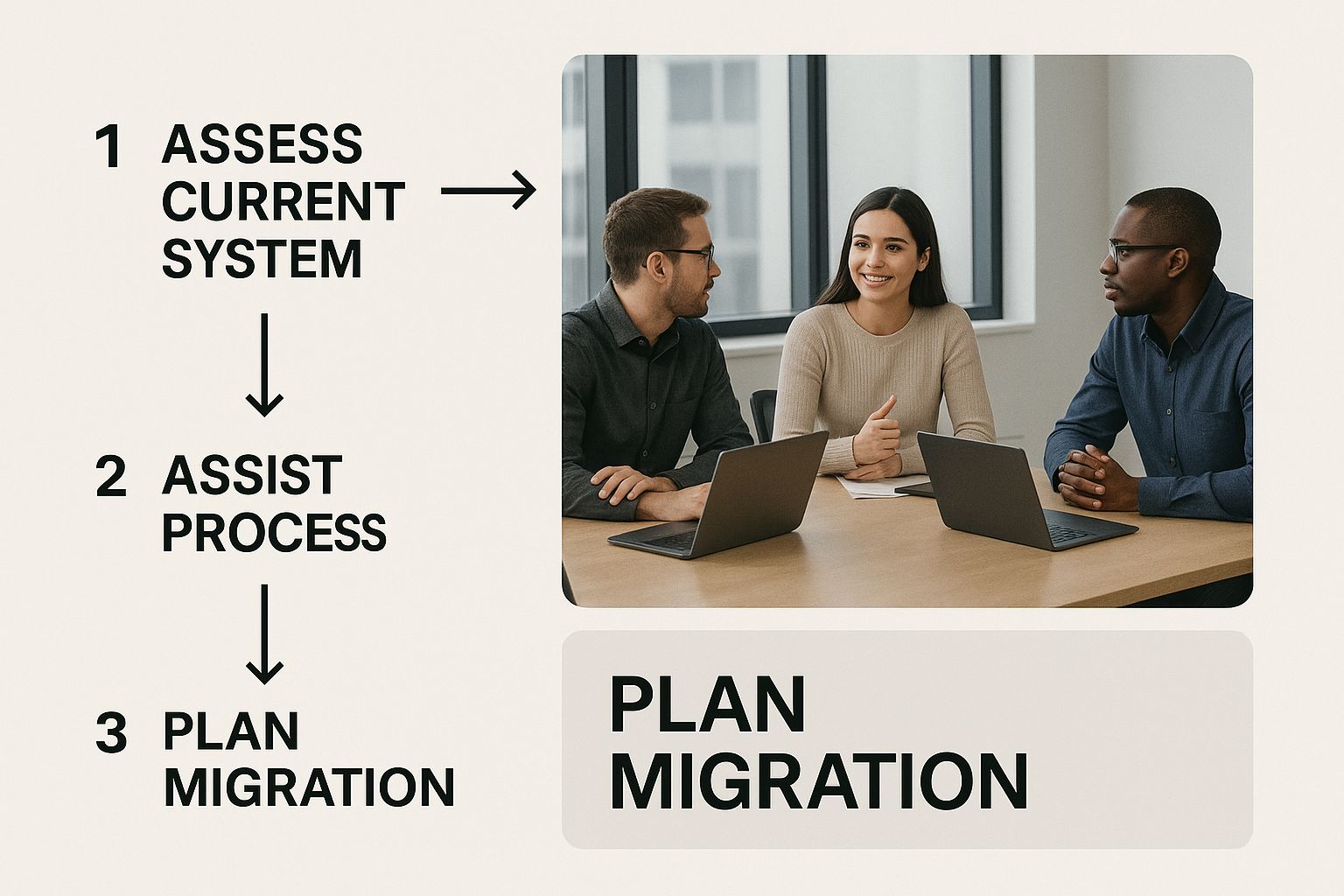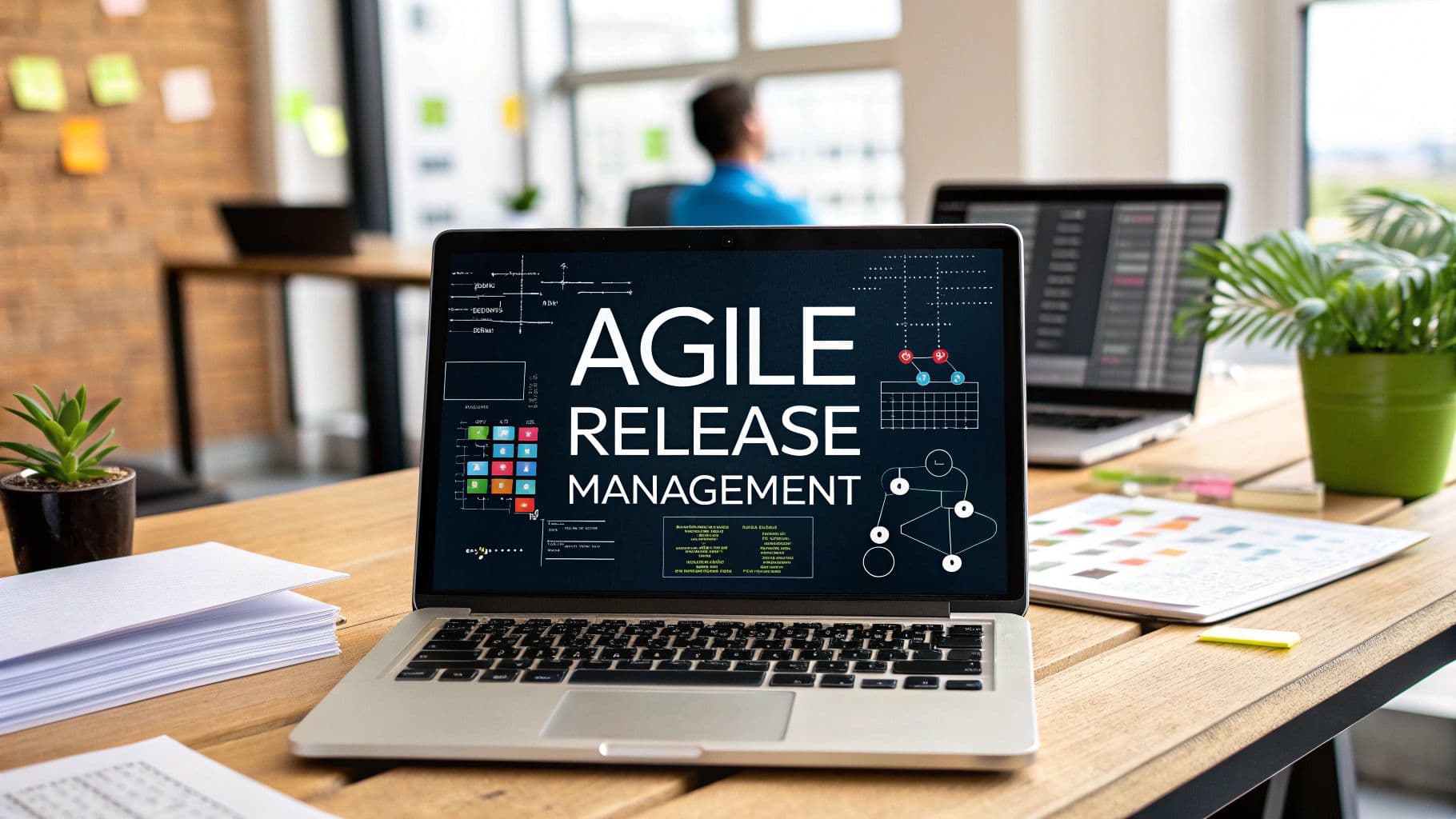database migration checklist
data transition
migration strategy
data integrity
migration planning
Database Migration Checklist: Ensure Smooth Data Transfers
Why Most Database Migrations Fail (And How to Beat the Odds)
Database migrations are essential for modernizing systems, improving performance, and scaling for future growth. But they are also notoriously difficult, often encountering unexpected problems. Think of it like moving your home: it's a complicated process that requires careful planning, detailed logistics, and carries the risk of losing or damaging valuable items. Database migrations are similar – it's much more than just moving data from one place to another.
Understanding the High Failure Rate
A surprising number of database migrations fall short of their goals. In fact, according to a 2025 Gartner report referenced by Quinnox, more than 83% of data migrations either fail completely or go significantly over budget and schedule. These failures occur for a variety of reasons, from poor planning and unforeseen technical issues to simple incompatibilities between systems. Such problems not only increase costs but also disrupt business operations, highlighting the need for a thorough database migration checklist. For a more detailed breakdown of these statistics, see this blog post.
One common cause of failure is a lack of communication between business stakeholders and the IT team. Without clearly defined and shared objectives, migrations can easily go off track. Another frequent issue is underestimating the project's scope. Migrating a database involves the data itself, but also the applications that use that data, the supporting infrastructure, and crucial security considerations.
The Importance of a Database Migration Checklist
A detailed database migration checklist is an invaluable guide. It acts as a roadmap, outlining each step from preparation to completion and ensuring no detail is missed. This checklist helps turn a potentially chaotic endeavor into a strategic initiative. Additional resources on database migration can be found on the pdf.ai blog.
Early Warning Signs and Stakeholder Alignment
Spotting potential issues early on is key to averting a migration disaster. A comprehensive checklist helps identify warning signs such as data inconsistencies, compatibility problems, or performance bottlenecks. For instance, if testing shows that data transfer speeds are slower than expected, adjustments can be made before the full migration begins.
Moreover, successful migrations prioritize stakeholder alignment from the beginning. This means involving everyone – from IT professionals to business users – to guarantee the migration supports overall business goals. This collaborative approach creates a shared understanding of the project and reduces the risk of miscommunication. By addressing these key aspects, organizations can significantly improve their chances of a smooth and successful database migration.
The 7-Step Framework That Makes Migrations Actually Work

The image above shows a typical database migration planning meeting. It highlights how important collaboration is throughout this process. These meetings are crucial for ensuring everyone understands the project’s scope and is on the same page. Open communication and a shared understanding are the foundation of effective planning. This creates a structured approach, minimizing errors and maximizing efficiency.
Database migrations can be daunting. However, a systematic approach significantly improves the likelihood of success. Database migration checklists typically use a 7-step process to manage these complex transitions. This framework offers structure for even the most challenging migrations.
For example, a 2024 Lumenalta resource highlights the first step: Defining Objectives. This involves outlining the reason for the migration (such as moving to the cloud or upgrading platforms), identifying all databases and related components, and establishing measurable metrics for success. Learn more about database migration checklists here.
To help illustrate this framework in more detail, we've put together a comprehensive checklist. This table breaks down each step, outlining key activities, deliverables, and common pitfalls to avoid.
The 7-Step Database Migration Checklist Framework: A comprehensive breakdown of each step in the database migration process, including key activities and deliverables.
| Step | Key Activities | Deliverables | Common Pitfalls |
|---|---|---|---|
| Defining Objectives | Document business goals, identify databases and components, establish success metrics. | Clearly defined objectives document. | Lack of clear business goals, incomplete inventory of databases. |
| Pre-Migration Assessment | Audit existing database environment, assess data quality, identify compatibility issues. | Assessment report outlining current state and potential risks. | Inadequate assessment leading to unforeseen issues during migration. |
| Data Preparation and Cleansing | Cleanse and validate data, remove duplicates, address inconsistencies. | Cleaned and validated dataset ready for migration. | Ignoring data quality issues, leading to problems in the target environment. |
| Target Environment Setup | Configure target environment, set up storage, configure security protocols. | Configured target environment ready to receive data. | Incompatibility between source and target environments. |
| Tool Selection | Evaluate and select appropriate migration tools. | Chosen migration tool and implementation plan. | Selecting a tool without proper evaluation. |
| Testing and Validation | Test migrated data in a staging environment, validate data integrity. | Test results and validation report. | Insufficient testing leading to undiscovered errors. |
| Execution and Monitoring | Execute the migration, monitor for issues, perform post-migration validation. | Successfully migrated database in the target environment. | Lack of monitoring and post-migration validation. |
This checklist serves as a valuable guide throughout the migration process. By addressing each step systematically, you can mitigate potential risks and ensure a smoother transition.
Defining Objectives
This initial phase establishes the reason for the migration. Clearly defined objectives ensure that technical efforts align with business needs. This step involves identifying the specific databases, schemas, and objects involved. It also establishes metrics for success, like achieving a specific data accuracy percentage or reducing operational costs.
Pre-Migration Assessment
A thorough audit of your existing database environment is crucial. This involves evaluating data quality, identifying potential compatibility issues, and understanding your current infrastructure. This information informs the selection of the right migration tools and the execution plan.
Data Preparation and Cleansing
Think of this stage as preparing your data for its new home. It focuses on improving data quality by addressing inconsistencies, removing duplicate entries, and validating formats. Clean data ensures a smooth transition and prevents issues in the target environment.
Target Environment Setup
This step involves setting up the new environment to receive the data. Tasks include setting up storage, configuring security, and ensuring compatibility with the source database. A properly configured target environment minimizes disruptions.
Tool Selection
Choosing the appropriate migration tool is a critical decision. Evaluate tools based on their features, compatibility, and your specific needs. Consider factors such as automated schema conversion, data validation capabilities, and support for various database types. AWS Database Migration Service is one example of a popular migration tool.
Testing and Validation
Thorough testing in a staging environment is essential. This helps identify potential problems and ensures data integrity after the migration. Comprehensive testing increases confidence and ensures the migrated data functions correctly.
Execution and Monitoring
This phase is the actual data transfer. It needs to be closely monitored for any issues. Continuous monitoring helps catch and resolve problems quickly. Post-migration validation ensures data accuracy and optimal system performance.
These seven steps create a robust framework. While every migration has its unique characteristics, this structured approach greatly increases the chances of a smooth transition and maximizes the benefits of the new database environment. For more on optimizing database performance post-migration, check out our blog post on database performance optimization.
Pre-Migration Prep: Clean Data and Environment Mastery

A successful database migration depends heavily on how well you prepare. It's not simply about moving data; it's about ensuring the data is clean and the new environment is properly configured before the migration begins. This proactive approach minimizes potential issues during the transfer, ultimately saving valuable time and resources.
Data Cleaning: The Foundation of a Smooth Migration
The first step is data cleaning. Think of it like decluttering and organizing your home before moving. You wouldn't bring broken items or unnecessary clutter into a new house, right? Similarly, migrating flawed data will only cause problems in your new database.
Data cleaning involves several key activities:
- Identifying corrupted records: This means finding entries with invalid formats or missing information.
- Eliminating duplicates: Removing redundant data improves efficiency and prevents conflicts in the new database.
- Ensuring data quality: Validating data types and formats ensures consistency and accuracy.
This process ensures the migrated data is accurate, consistent, and ready for use in its new home.
Target Environment Configuration: Setting the Stage for Success
Once the data is clean, the focus shifts to configuring the target environment. This means setting up the new database to optimally receive and manage the incoming data. A well-configured target environment is like a perfectly arranged house, ready to welcome its new occupants.
Here's what this entails:
- Storage Allocation: Determining the necessary storage capacity and configuring it for optimal performance. This prevents bottlenecks during migration.
- Schema Alignment: Ensuring compatibility between the source and target database schemas. This preserves critical data relationships, much like ensuring your furniture fits in your new home before the movers arrive.
- Security Protocols: Implementing security measures such as role-based access controls (ACLs) and authentication protocols. This protects your data during the vulnerable transition.
These steps create a robust and secure foundation for the migrated data.
Automation and Documentation: Streamlining the Process
Automation plays a vital role in reducing manual errors during migration. Automated tools can handle syntax translation between different database systems, eliminating tedious and error-prone manual conversions. This streamlines the migration process, saving time and effort. Check out this comparison of Supabase vs. Firebase.
Detailed documentation is another crucial aspect of pre-migration preparation. This should cover everything from data cleaning procedures to target environment configurations. Good documentation serves as a valuable resource for the current migration team and provides guidance for future projects. It prevents institutional knowledge loss and ensures consistency across migrations. A comprehensive data migration checklist, such as the one published by Rivery, emphasizes the importance of these preparatory tasks. Learn more about creating a complete data migration checklist.
By meticulously addressing data cleaning, environment configuration, automation, and documentation, you build a solid foundation for a successful database migration. This thorough pre-migration prep minimizes problems, streamlines the process, and ensures a smooth transition to your new database environment. It sets the stage for an efficient and successful migration.
Risk Mitigation: Protecting Your Business While Migrating
A database migration, even with the most detailed checklist, can present unexpected hurdles. It’s similar to planning a long-distance move: even with careful packing and meticulous scheduling, unforeseen delays or roadblocks can still appear. This is why risk mitigation is so important. It involves proactively identifying potential issues and developing solutions before they impact your business.
Building a Risk Matrix: Prioritizing Potential Threats
A risk matrix helps you visualize and prioritize potential problems based on their probability and potential effect on your business. Think of it as a heat map, with high-probability, high-impact risks marked as the most urgent. This allows you to concentrate on the areas that pose the greatest threat to your migration. For example, data corruption would be a high-impact risk, while a small delay might be low-impact. As part of pre-migration preparation, understanding the implications of data changes is crucial; this resource on changing data sources offers valuable insights.
Contingency Planning: The Art of the Rollback
Even with thorough planning, things can still go wrong. This is where contingency planning comes in. It's like having a backup plan in case your moving truck breaks down. A key element of contingency planning is the rollback procedure. This is a predefined process for returning to the previous database state if the migration fails. A well-defined rollback procedure minimizes both downtime and data loss, ensuring business continuity even when unexpected issues arise. For further reading on business continuity and adapting to different payment landscapes, you might find this helpful: How to master payment providers.
Early-Warning Monitoring: Detecting Problems Before They Escalate
Imagine your moving truck has real-time GPS tracking that alerts you to traffic jams or road closures. Early-warning monitoring systems in database migrations function similarly, detecting issues before they become major problems. These systems monitor essential metrics such as data transfer speeds, error rates, and system performance.
For example, if the system detects an unusually high number of data errors, it can trigger an alert, allowing the team to intervene before the problem escalates. This proactive approach reduces downtime, prevents cascading failures, and keeps the migration on schedule.
Compliance: Navigating Regulated Industries
For businesses in regulated industries, compliance is critical during a database migration. This involves handling data sovereignty issues, adhering to privacy regulations (such as GDPR or HIPAA), and meeting industry-specific requirements. Failing to address these compliance needs can result in serious legal and financial repercussions. This necessitates incorporating specific security measures and protocols into migration plans to protect sensitive data throughout the entire process.
Real-World Examples: Learning from Experience
One example of successful risk mitigation involves a healthcare company migrating patient data to a new cloud-based system. They implemented strong data encryption and access controls throughout the migration, ensuring patient privacy and HIPAA compliance. Another example is a financial institution migrating its transaction database. They prioritized contingency planning and created a detailed rollback procedure to guarantee business continuity in the event of any migration failures. These examples demonstrate how proactive risk mitigation safeguards both data and business operations during a database migration.
Testing That Actually Prevents Migration Disasters

Testing isn't just another item on your database migration checklist. It's the crucial safeguard against potential catastrophes, the difference between a smooth transition and a major business disruption. This means moving beyond simple checks and establishing a truly comprehensive testing framework.
Building A Comprehensive Testing Framework
Organizations that consistently succeed with database migrations understand the need for multi-layered testing. This starts with unit testing, validating individual database components. Think of it like testing individual engine parts before assembling the entire engine. Verifying that stored procedures work correctly in isolation is a good example of a unit test.
Integration testing, on the other hand, ensures different database components work together harmoniously. This is like making sure the entire car–engine, transmission, and brakes–functions correctly as a whole. Testing your application's interaction with the migrated database is a key aspect of integration testing.
Finally, performance testing is essential to prevent post-migration slowdowns. This is the equivalent of a test drive, ensuring the car performs well under real-world conditions. A prime example of this is measuring query execution times in the new database environment.
Designing Effective Test Cases
The effectiveness of your testing relies heavily on well-designed test cases. These cases must thoroughly validate data integrity across all systems. For instance, confirming consistent data values after migration is critical.
Ensuring schema compatibility between environments is equally important. This prevents broken data relationships during the transfer and requires a detailed schema comparison before migration.
Creating Realistic Test Environments
Uncovering hidden issues requires a realistic testing environment. Successful teams create test environments that closely mirror production conditions. This includes not just the data but also the hardware, software, and network setup.
They also use representative test data – data similar in size and characteristics to real data – to expose potential issues before they impact your live system. Simulating peak user load in the test environment is a key part of this process.
Automating For Efficiency
Automation is the key to thorough and efficient testing. Automated tools can rapidly execute thousands of tests, finding errors that would be difficult to detect manually.
Many tools are designed specifically for database migrations. Some even facilitate automated schema comparisons, data validation checks, and performance benchmarking. These tools not only speed up the testing process but also minimize human error.
To help you understand the various testing methods, we've put together a comparison table.
The table below, "Database Migration Testing Comparison," provides a breakdown of different testing methodologies for database migrations, highlighting their advantages, challenges, and ideal use cases. It also includes common tools used for each method.
Database Migration Testing Comparison
| Testing Method | Key Benefits | Limitations | When to Use | Tools |
|---|---|---|---|---|
| Unit Testing | Isolates problems in specific components; easier to debug. | Doesn't test interactions between components. | During development, after code changes. | DBFit, tSQLt |
| Integration Testing | Verifies interactions between components; catches system-level errors. | More complex to set up and debug. | After unit testing, before performance testing. | JUnit, pytest |
| Performance Testing | Ensures system performance meets requirements; identifies bottlenecks. | Can be resource-intensive; requires realistic test data. | After integration testing, before production deployment. | JMeter, k6 |
This table offers a quick overview of how different testing methodologies can be implemented at various stages of your database migration project. Selecting the right method and the right tools will greatly contribute to the success of your migration.
By following these comprehensive testing strategies, organizations can drastically reduce migration risks, ensuring a smooth, efficient, and successful transition. This structured approach not only protects data integrity but also maintains business continuity during and after the migration. Ultimately, it builds confidence in the new database environment, contributing to the overall success of your migration project.
From Pilot to Full Migration: Making the Transition Real
The critical moment in any database migration is the data transfer itself. This is where all the planning and testing comes to fruition. This section explores proven strategies for navigating this vital step. Think of it like the final walkthrough before buying a new house – you want to make sure everything is perfect before fully committing.
Pilot Migration: A Test Run
Before migrating your entire database, a pilot migration using a subset of your data is essential. This allows you to identify any potential issues without jeopardizing the entire dataset. This test run should mirror real-world conditions as accurately as possible. Use data that reflects the variety and complexity of your production environment. For instance, if your database contains different data types like text, numerical data, and images, your pilot data should also include all of these. This lets you refine the migration process and tackle unexpected problems in a safe environment.
Setting Benchmarks for Success
Well-defined success criteria are essential for deciding the next steps after the pilot migration. These criteria should be measurable and linked to business goals. Data accuracy, transfer speed, and application functionality are good examples of measurable success criteria. If the pilot migration meets these benchmarks, you can proceed with confidence. If not, you may need to re-evaluate previous stages of your database migration plan or even consider a different approach altogether. This framework helps you make informed decisions based on the data.
Timing is Everything: Minimizing Disruptions
Careful scheduling is paramount to reduce downtime and impact on your business. Consider migrating during off-peak hours or weekends when system usage is lower. Effective downtime management techniques, such as using staged migrations or maintaining temporary redundant systems, can minimize disruptions. Communicating planned downtime clearly to stakeholders via regular updates is vital for setting expectations and ensuring a smooth transition.
Real-Time Monitoring: Staying One Step Ahead
Real-time monitoring during the migration offers immediate visibility into potential issues. Using monitoring tools lets you track progress, pinpoint bottlenecks, and resolve problems before they escalate. Monitoring tools can track things like data transfer speed, error rates, and resource utilization. For example, if the transfer speed drops suddenly or error rates spike, you can swiftly investigate and implement solutions. This prevents costly delays and safeguards data integrity. This proactive approach protects your business from major disruptions and contributes to a successful migration.
The Final Decision: Is it Go Time?
The decision to fully switch to the new database requires careful evaluation of multiple factors. The key is a clear decision-making process. Have the success criteria been met? Are monitoring systems showing stable performance? Is your team prepared? These questions will help determine the best time for cutover. A phased rollout, starting with non-critical applications, can further mitigate risk. This allows for ongoing testing and validation in the new environment before migrating all systems. AnotherWrapper provides a complete starting kit for building AI-powered products that integrate seamlessly into your new database setup, maximizing the benefits of your migration.
After Migration: Validation, Optimization, and Success
Your database migration isn't finished just because the data has moved. It's only complete when your business is thriving with the new system. This final stage is just as critical as the migration itself, solidifying your efforts and paving the way for long-term success.
Comprehensive Validation: Ensuring Data Integrity
After the technical aspects of the migration are done, the first order of business is confirming the accuracy and completeness of your data. Data validation methodologies verify that all data has been transferred correctly and completely between the source and target systems. It’s like checking off every item on a moving inventory list after arriving at your new home. This might involve comparing record counts, checksums, or running queries to verify data consistency. Ensuring that no data was lost or corrupted during the transition is paramount to preserving the integrity of your business information.
Performance Benchmarking: Identifying Areas for Improvement
Once the data's integrity is confirmed, it’s time to evaluate performance. Performance benchmarking involves measuring key performance indicators (KPIs) such as query response times, transaction throughput, and resource utilization. This establishes a baseline for future optimization. Imagine timing yourself on a familiar route after getting a new car. You want to be sure the new system performs at least as well as the old one, if not better. By comparing pre- and post-migration performance, you can identify areas for improvement. For more information on enhancing database performance, check out this resource: How to master database performance optimization.
Application Testing and User Feedback: Refining the System
Even with thorough pre-migration testing, it's crucial to retest your applications within the new environment. Application testing post-migration verifies that all business functions remain operational and perform as expected. This often involves collaborating with end-users to guarantee a smooth transition and gather their feedback on the new system. This feedback is essential for identifying and resolving any usability problems or unexpected behavior within the new environment.
Knowledge Transfer and Documentation: Supporting Long-Term Maintenance
Successfully migrating a database takes more than just moving data; it requires transferring knowledge and maintaining comprehensive documentation. Knowledge transfer processes prevent institutional memory loss by ensuring the team responsible for ongoing maintenance understands the new system’s complexities. This might include training sessions, documentation reviews, and internal knowledge sharing.
Documentation is equally critical for long-term support. This should detail the migration process, system configurations, and any troubleshooting steps taken. This detailed record acts as a vital resource for future updates, upgrades, or even subsequent migrations.
Post-Migration Review: Capturing Valuable Lessons
Finally, conducting a post-migration review is an invaluable practice. This involves analyzing the entire migration process, identifying what worked well, and pinpointing areas for improvement in future projects. It’s like a post-move debriefing, allowing you to refine your approach for next time. This retrospective analysis captures valuable lessons learned, contributing to a continuous improvement cycle for future migrations.
Building and scaling AI-powered products is simplified with a successful database migration. AnotherWrapper provides an excellent foundation, offering a comprehensive AI starter kit to accelerate your development process. With its integrated Supabase platform and pre-built demo applications, you can quickly use your newly migrated data to build innovative AI solutions.
Fekri




